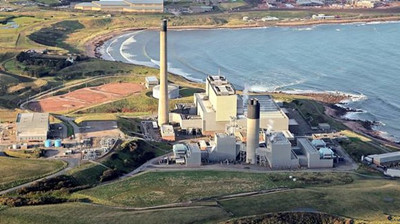捕捉碳
Pipe dreams
管道之夢
A fresh effort to store pollutants underground.
將污染物儲存地下的新嘗試。
FOR more than 30 years Peterhead power station has churned out electricity from a windswept spot on the north-east coast of Scotland. Its chimney (pictured) is a familiar landmark for strollers on Aberdeen's chilly beach. Yet soon the ageing gas-fired plant could host a crucial experiment. Engineers from Shell, an oil firm, and SSE, an energy company, plan to add technology that will capture the carbon dioxide which billows from Peterhead's furnace and store it in a depleted gasfield more than a mile beneath the North Sea. That could cut its emissions by up to 90%, making Peterhead by far the cleanest gas plant in the world.
Peterhead 電廠位于蘇格蘭東北部一處風不止歇的地方,長期輸送電力超過30年。它的煙囪成為Aberdeen的冷灘散步者所熟知的地標。不過很快這座老化的燃氣電廠將要面臨一項關鍵的考驗。來自殼牌石油公司和SSE能源公司的工程師們計劃對這座電廠進行技術改造,這樣就可以捕捉從Peterhead電廠鍋爐中大量涌出的二氧化碳,并將之儲存到一座廢棄的油田中。而這座油田深藏在北海一英里以下。成功之后將比以前減少90%的二氧化碳排放量,Peterhead將成為迄今世界上最清潔的燃氣電廠。

Peterhead is one of two preferred bidders in a government contest that aims to kick-start Britain's adoption of carbon capture and storage technologies. The other pet project is a proposed coal-fired plant at Drax power station in Yorkshire, which will pipe its pollutants about 50 miles to the coast before trapping them in rocks beneath the waves. Yet politicians have been soliciting similar proposals since 2007, without bringing any to fruition; abortive efforts at Peterhead go back even further. Boosters hope this latest crop will buck a sorry trend.
Peterhead是政府競標項目中兩個被選中的競標項目之一。此次競標旨在促使不列顛上下采用碳捕捉和儲存技術。另外一項受重視的項目是計劃對約克郡的Drax電廠的煤電機組進行改造。這項改造目的在于將污染物輸送到離海岸線有50英里的地方并將之固定在波濤之下的巖層中。不過政客們早在2007年就作出過相同的許諾,也沒帶來任何成果;對Peterhead改造的流產甚至退回原地。支持者們希望這遲來的成效能在未來挽回慘淡的局面。
The rewards could be great. CCS is one of a very few ways to clean up industries such as steelmaking or chemicals. Fossil-fuel power stations fitted with carbon-capturing kit would provide an unusually flexible source of green power.
回報相當豐厚。CCS是為數不多可以清潔諸如煉鋼廠或化學工廠的法子。化石燃料的電廠配備上碳捕捉裝置之后,可以提供具有相當彈性供應量的清潔能源。
These benefits would bring savings. Carbon capture could be lopping 30 billion off Britain's annual energy bill by 2050, says the Energy Technology Institute, a government and industry research body. The International Energy Agency, an intergovernmental outfit, reckons CCS will have to deliver one-sixth of the emissions cuts required to limit the damage done by climate change, and that forgoing it would raise costs by 40%.
這些好處可以節省很多開支。據政府和工廠的研究機構,能源技術研究所稱,到2050年,碳捕捉技術有望為不列顛每年砍去300億英鎊的能源開支。而據一座跨國機構國際能源所認為,采用CCS技術將減少六分之一的碳排放,這可以減少因此造成的氣候而帶來的損失。而如果放棄這項技術將導致損失上升40%
Britain is well placed to cash in. Its wealth of underwater engineers will need new ways to keep busy as the North Sea's fields run dry. A steady supply of carbon could be useful to roughnecks, who are experimenting with techniques that use the gas to squeeze more oil from mature wells. And the country's deep aquifers and depleted reservoirs could probably hold 100 years-worth of emissions.
不列顛是實行這項技術的好地方。在北海油田日漸枯竭的時候,她數量眾多的水下工程師需要新的渠道維持飯碗。穩定的碳供應對于礦工來說也是極為有用的,因為目前他們正在嘗試新技術:利用二氧化碳從成熟油井中擠壓出更多的石油。而這個國家深度蓄水層和廢棄的儲油層足夠容納英倫百年的排放的二氧化碳。
That makes slow progress all the more frustrating. In May MPs on the climate-change select committee complained that government dithering had led to a “lost decade” for CCS in Britain. Money is part of the problem—boffins say energy from the first CCS plants could cost 150-200 per megawatt hour, four times the current wholesale price of power and more expensive even than offshore wind farms. European laws that oblige Britain to invest heavily in renewables are diverting resources away from CCS, says Judith Shapiro, an industry spokesperson.
不過這進步來得少,挫敗倒更多。在5月的時候,氣候變化選擇委員會的議員們抱怨道,由于政府的優柔寡斷猶豫不決,導致CCS技術在不列顛停滯了10年。資金是其中的問題之一—研究者指出采用CCS技術的工廠最初每兆瓦·時要花費150鎊到200鎊,這是現行整體能源價格的4倍,其昂貴程度較之離岸風能電廠不逞多讓。歐盟法律敦促不列顛在再生能源領域加大投資,這促使很多資金從CCS流失。一位工業發言人Judith Shapiro如是說。
Yet the government is digging deep to make sure its latest efforts pay off. In 2007 it put aside 1 billion to help fund the capital costs of some CCS projects—not least the huge expense of laying new pipelines overland. Lately it has also promised ongoing subsidies of the type given to renewables. Bosses at Peterhead and at Drax say that next year they hope to make a final decision on whether or not to press ahead.
雖然如此,政府仍在加大努力確保最近的努力措施能夠有所斬獲。在2007年,政府留出10億英鎊設立基金以支付一些CCS項目的支出—這也包括鋪設離岸新管道的巨額花費。最近,政府也承諾在許可的范圍的內逐步減少對再生能源項目的支持。Peterhead和Drax的老板說下一年他們希望希望作出一項財政決議,以便于決定CCS項目是否繼續進行。
Pessimists say that a few pilot projects will not make an industry, even if the technology proves viable. Some fret that runners-up in the government's competition will run out of money while it mulls what subsidies to offer; others warn of bottlenecks without more efforts to identify storage sites. One big uncertainty is how the public will react when plans for carbon capture are better known. Though engineers have been cramming carbon underground for several years—notably in Norway—the idea could still spark alarm. That would not easily go back in the bottle.
悲觀論者認為一木不成林,少數先行的項目不足以支撐出一個產業體系,哪怕實踐證明這項技術切實可行。一些人對政府的行徑感到焦慮。他們認為這種競爭將耗完所有的資金,而它需要通盤考慮補貼誰;另外一些人則提醒,不花費更多精力去甄別存儲地點是存在問題的。一個最大的不確定在于碳捕捉計劃廣為人知之后公共將作出何等反應。盡管工程師已經把碳壓縮到地底這事已經干了很多年了——在挪威最典型——公眾的反對仍能成燎原之勢。這不像二氧化碳,能夠輕易關進瓶子里。












